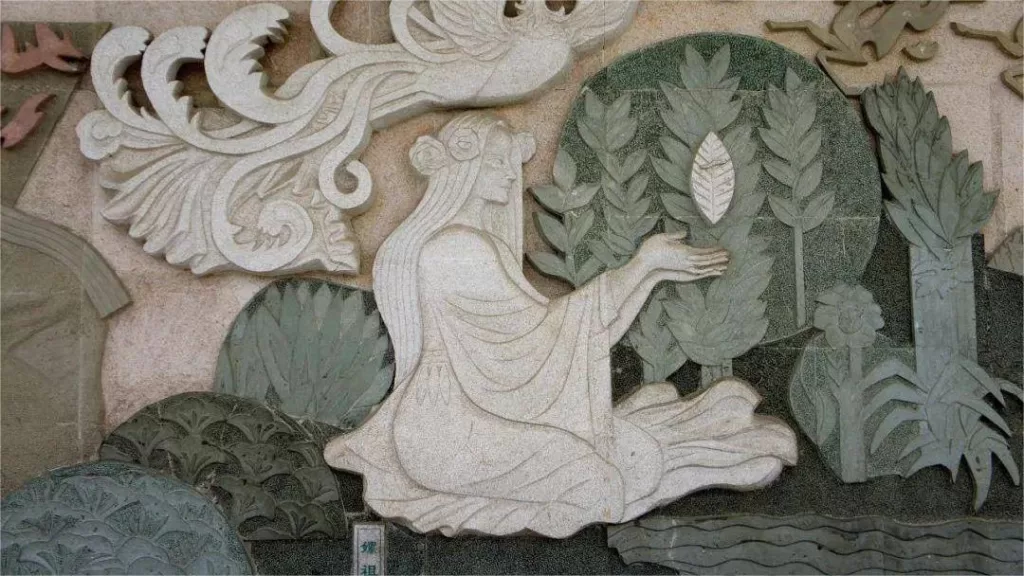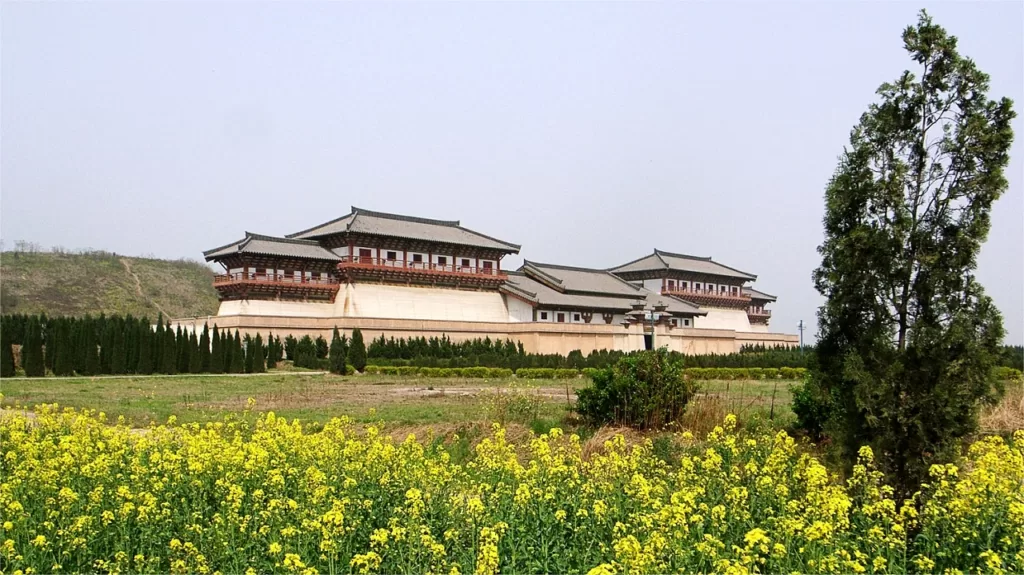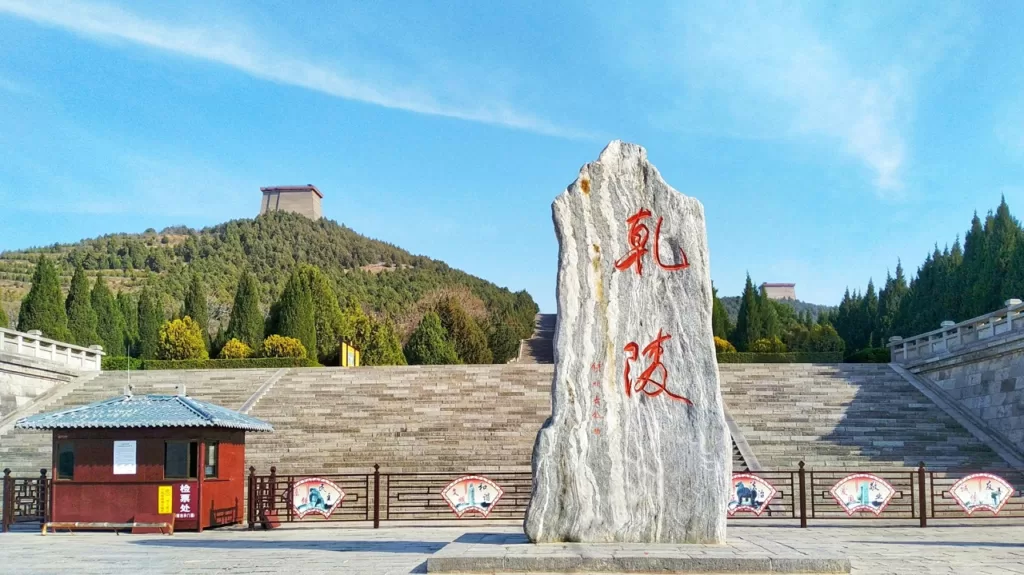The Mausoleum of the Yellow Emperor, also known as “Huangdi Ling (黄帝陵),” is an extraordinary burial site and a revered place of ancestral worship, dedicated to the founding ancestor of the Chinese nation, Emperor Xuanyuan, commonly known as the Yellow Emperor. While there are several sites across the country bearing the name “Huangdi Ling,” the one located in Huangling County holds special significance, as it is designated as a national key cultural heritage site. This magnificent mausoleum is enveloped by ancient cypress trees, and successive Chinese governments have placed great importance on preserving these venerable trees surrounding the Yellow Emperor’s resting place.
The Mausoleum of the Yellow Emperor is divided into two main sections: the Xuanyuan Temple and the Huangdi Ling Park. The Xuanyuan Temple, also referred to as the Huangdi Temple, stands with its main entrance facing north. It was initially constructed during the Han Dynasty and comprises significant structures such as the temple gate, the Sincerity Pavilion, the Memorial Pavilion, and the Hall of the First Ancestor of Humanity. The temple precinct is graced by 16 ancient cypress trees. Since the fifth year of the Tang Dynasty’s Dali era (770 AD), it has served as the location for annual national ceremonies held by successive dynasties. After the establishment of the People’s Republic of China, annual memorial ceremonies continued to be held on Tomb-Sweeping Day (Qingming Festival) and the Double Ninth Festival (Chongyang Festival).
Table of Contents
- Basic Information
- Location and Transportation
- Highlights of the Yellow Emperor’s Mausoleum
- Map of Yellow Emperor’s Mausoleum
- Vlog about Yellow Emperor’s Mausoleum
- Useful Tips Summarized from Reviews
- Facts about Yellow Emperor
- Other Mausoleums in Shaanxi
Basic Information
| Website | http://hdl.yanan.gov.cn/ |
| Estimated Length of Tour | 3 hours |
| Ticket Price | 75 RMB (1st March – 30th November) 50 RMB (1st December – 28th February the next year) |
| Opening Hours | 08.00 – 18.00; Last admission: 17.00 (1st December – 28th February the next year) 07.30 – 18.30; Last admission: 17.30 (1st March – 30th November) |
Location and Transportation
The Mausoleum of the Yellow Emperor is located in Huangling, Yan’an, a city in the northern part of Shaanxi province and is known for its rich cultural and historical heritage. It is in a scenic area on the southern slope of Qiaoshan Mountain, which is about 7 kilometers east of the city center. To get there from Xi’an, you can choose the following ways:
- Take an express train at Xi’an Railway Station to Huangling County. There are 5 trains a day, departing at 8.36, 11.40, 13.30, 14.17, and 19.48 respectively. The journey takes around 2 hours and costs 32 – 55 RMB.
- Take a taxi to reach the mausoleum. This part of journey covers 17 kilometers and costs about 80 RMB. You can show the following text to the driver: “请带我去黄帝陵”.
Highlights of the Yellow Emperor’s Mausoleum
Yellow Emperor’s Tree

Within the Xuanyuan Temple’s entrance on the western side, there stands a magnificent ancient cypress tree known as the “Cypress Planted by the Hand of the Yellow Emperor.” This tree, believed to be more than 5,000 years old, is said to have been planted by the Yellow Emperor himself, earning it the titles “Cypress Planted by the Hand of the Yellow Emperor” or “Xuanyuan Cypress.” The ancient cypress tree stands tall and straight, with lush green leaves and a slight southward inclination of its main trunk. It reaches a height of 19 meters and has a trunk diameter of 11 meters, with a sprawling canopy that creates a majestic and imposing presence. The Cypress is the oldest surviving cypress tree in China and, as confirmed by British forestry expert Roper in 1982, it is the largest and oldest cypress tree in the world.
The Gate and Hall

The main gate, or Shanmen, is situated along the central axis of the Xuanyuan Temple. This stone structure, designed in the style of the Han Dynasty, spans an area of 224 square meters. It features a layout with five open bays, and the 18 granite columns, each 4.8 meters tall, are integrated into one continuous piece of stone. The temple gate’s platform stands 2.72 meters higher than the square in front of it. Above the temple gate, there is an inscription plaque that reads “Xuanyuan Temple,” which was written by Mr. Jiang Dingwen during the Tomb-Sweeping Day in 1938.
The Xuanyuan Hall, covering an area of 1,700 square meters, is enclosed by 36 round stone columns, each standing at 3.8 meters in height, forming a rectangular space measuring 40 meters by 40 meters. The absence of walls between the columns creates an open, pavilion-style structure, topped with a grandiose and historical roof, representing the “Bright Hall of the Yellow Emperor.” The long eaves, massive brackets, and the simple yet classical roof ridges impart grandeur and solemnity to the building, displaying ancient Han Dynasty architectural styles. At the center of the roof, there is a circular skylight with a diameter of 14 meters, allowing direct sunlight, blue skies, and white clouds to illuminate the entire space, creating a magnificent and sacred atmosphere.
The Stele Pavilion

The Stele Pavilion, situated in the middle of the memorial garden, features brick walls on both its eastern and western sides. It has a width of five bays and a depth of one bay, with a passage in the middle. Before 1987, the Beiting Pavilion held 47 stone tablets, but in 1988, most of them were relocated to the Tablet Corridor on the east side of Xuanyuan Temple. Currently, four stone tablets remain in the pavilion. Among them, two on the western side are notable. The first is the “Inscription for the Sacrifice to the Yellow Emperor” with Mao Zedong’s handwriting, dated April 5, 1937, when both the Nationalists and Communists held a joint ceremony at Huangling. The second tablet is an inscription by Deng Xiaoping for the Yellow Emperor’s Mausoleum, featuring the four Chinese characters “炎黄子孙” (Descendants of Yan and Huang) inscribed by Deng Xiaoping himself in 1988.
The Scenic Area

The scenic area surrounding the Mausoleum of the Yellow Emperor is a breathtakingly beautiful landscape that offers visitors a chance to experience the natural beauty. The mausoleum is located on the southern slope of Qiaoshan Mountain and is surrounded by lush forests and scenic hiking trails. Visitors can enjoy stunning panoramic views of the surrounding mountains and valleys and explore other cultural and historical attractions around, such as the Yellow Emperor’s Tree and the Yan’an Revolutionary Memorial Hall.
Map of Yellow Emperor’s Mausoleum

Vlog about Yellow Emperor’s Mausoleum
Useful Tips Summarized from Reviews
Timing of Visit: Consider visiting the Yellow Emperor’s Mausoleum during significant events such as the 9th day of the ninth lunar month and the Qingming Festival when traditional worship ceremonies take place. These occasions offer a unique opportunity to experience the cultural heritage associated with the mausoleum.
Layout of the Mausoleum: The mausoleum is divided into two parts. The lower part features ancient cypress trees believed to have been planted by the Yellow Emperor himself 5000 years ago, as well as inscriptions by various historical figures. The upper part contains the burial mound.
Transportation Options: To reach the upper part of the mausoleum, you can take an electric car part of the way and then proceed on foot. The environment along the route is serene and peaceful. Additionally, there is a post office where you can send postcards to yourself or loved ones for a fee of ten yuan. These postcards will bear the postmark of the Chinese zodiac sign corresponding to your birth year and your surname.













In the Mausoleum of the Yellow Emperor, there are mainly stone tablets for sacrifices. Personally, I found it quite boring. The only highlight was the ancient 5,000-year-old tree. But having to pay for tickets makes it feel not worth it.